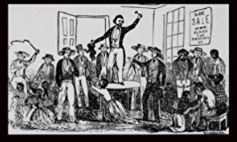We begin the first of four blogs focusing on African Americans in Antebellum Virginia with a look at the enslaved themselves in North America and Virginia in “Generations of Captivity”, then “The Slaveholding Republic” looks at the U.S. Government’s complicity in the slavery establishment throughout the South and in western territories.
“The World the Slaveholders Made” sees American patriarchal slavery seeking to assure security to owner, black worker and slave society based on racism. “Slave Laws in Virginia” considers the application of the state law relative to racism, proslavery ideology and public opinion.
These books are all used in bibliographies found in peer-reviewed surveys of Virginia history of scholarly merit. Additional insights are used from articles in the Virginia Magazine of History and Biography, the Journal of Southern History and the Journal of American History.
For book reviews at The Virginia Historian.com in this historical period for other topics, see the webpage for Antebellum, Civil War, Reconstruction. General surveys of Virginia History can be found at Virginia History Surveys. Other Virginia history divided by topics and time periods can be found at the webpage Books and Reviews.
Generations of Captivity

Generations of Captivity: A History of African-American Slaves was written by Ira Berlin in 2003 and reprinted in 2004, available now in paperback. The concepts of slavery and freedom saw continual change over the course of three hundred years in North America. Berlin chooses to focus on the slaves living under various degrees of freedom and terms of captivity with their families and in their communities.
The author describes five eras or “generations”. Charter generations of the 1600s were entrepreneurial and could achieve substantial social and economic independence. With the plantation revolution cultivating tobacco in the Chesapeake, the plantation generations imposed institutions to subordinate blacks to whites.
Revolutionary generations were held out the promise of larger liberty, but most remained under restrictive planter control. Migration generations of the 1800s were massively relocated into the booming cotton fields of the Deep South, a “Second Middle Passage” of more stringent control, while Upper South owners loosened restrictions to allow for hiring slaves out, slave-cultivated crops and buying their own freedom. The Freedom generations applied the lessons of slavery to their newly acquired status after emancipation. Learn more to buy “Generations of Captivity” here for your bookshelf.
The Slaveholding Republic

The Slaveholding Republic: An Account of the United States Government’s Relations to Slavery was written by Don E. Fehrenbacher and edited by Ward M. McAfee in 2001 and reprinted in 2002, now available in paperback. After analyzing the original Constitution as neutral regarding slavery, Fehrenbacher describes how the federal government became implicated in the institution of slavery, becoming congenial to it even as it became increasingly isolated in the southern national minority.
Pro-slavery policy shaped America’s foreign policy before 1861, the federal government came to intervene in the northern states over fugitive slaves and in the territories over the establishment of slavery. Over time there came to be a hardening in the positions staked out by the two sections, and finally in the crucible of war the federal government adopted abolition as a war aim. Learn more to buy “The Slaveholding Republic” here for your bookshelf.
The World the Slaveholders Made

The World the Slaveholders Made was written by Eugene D. Genovese in 1969 and reprinted in 1988, available now in paperback. In the book two essays explore his Marxist interpretations of history. The first relates the class and racial components of Western Hemisphere slavery as capitalistic, bourgeois versus seigneurial, patriarchal. The American Southern planter resembled the Brazilian in patriarchal structures. More independent of European metropolitan markets, they resisted abolitionism. Among the American planters, Genovese found the patriarchal brought about a kind of paternalism, the more profit seeking were more harsh and exploitative.
The second essay explores the pro-slavery, anti-capitalist thought of Virginian George Fitzhugh. His rationale for slavery asserted greater security than nineteenth century capitalism for owners, workers and society in general. Learn more to buy “The World the Slaveholders Made” here for your bookshelf.
Slave Laws in Virginia

Slave Laws in Virginia was written by Philip J. Schwarz in 1996 and reprinted in 2010, available now in paperback. It examines how whites viewed slave law-breakers, their responses in the variable administration of the law, and the responses to the legal regime by the slaves themselves. Africans arrived with their own legal traditions, and these conditioned their responses to Virginian law, and guided their own punishments for blacks committing crimes on blacks.
The essay on Thomas Jefferson as an example showed both merciful administration and cruel enforcement of the letter of the law. While slave law often prescribed the death penalty, many slave court justices suspended the sentence, while continuing punishment at the whipping post. A common commutation in the 1800s was transportation of the offender from Virginia into the Deep South. While ordinances became increasingly harsh against runaways who sought permanent escape, their numbers increased yearly until the end of the Civil War. Learn more to buy “Slave Laws in Virginia” here for your bookshelf.
For book reviews at The Virginia Historian.com in this historical period for other topics, see the webpage for Antebellum, Civil War, Reconstruction. General surveys of Virginia History can be found at Virginia History Surveys. Other Virginia history divided by topics and time periods can be found at the webpage Books and Reviews.

